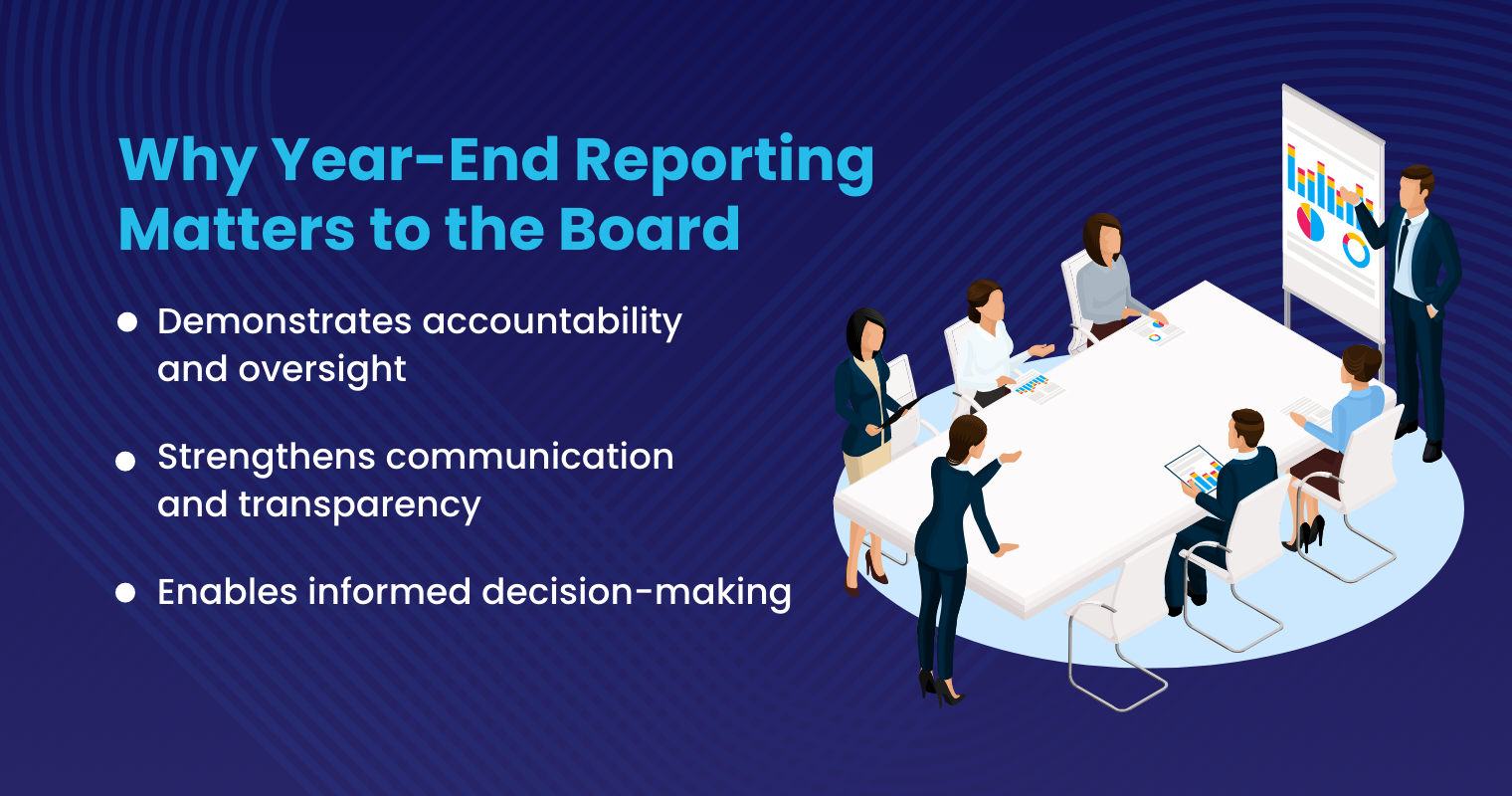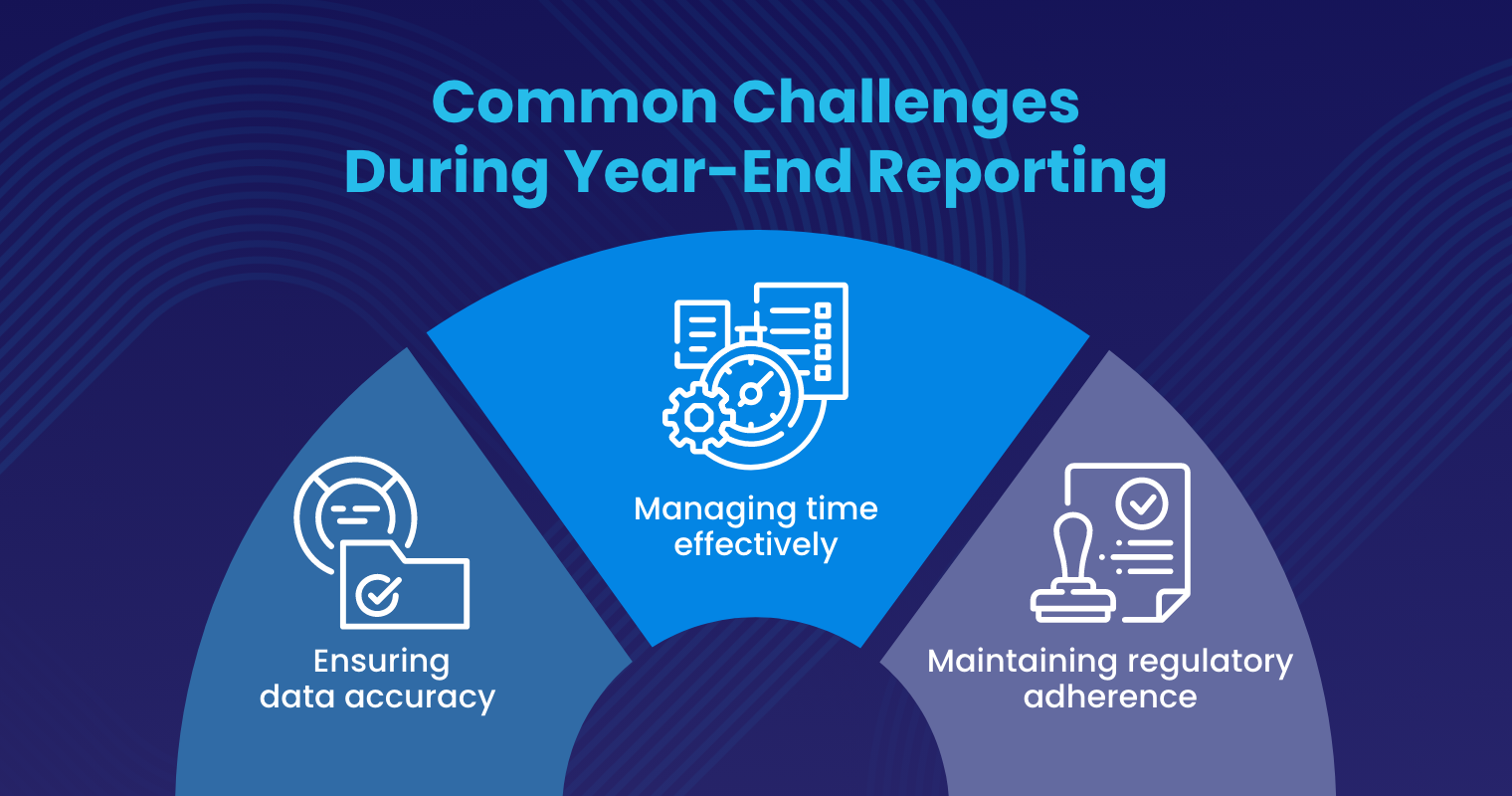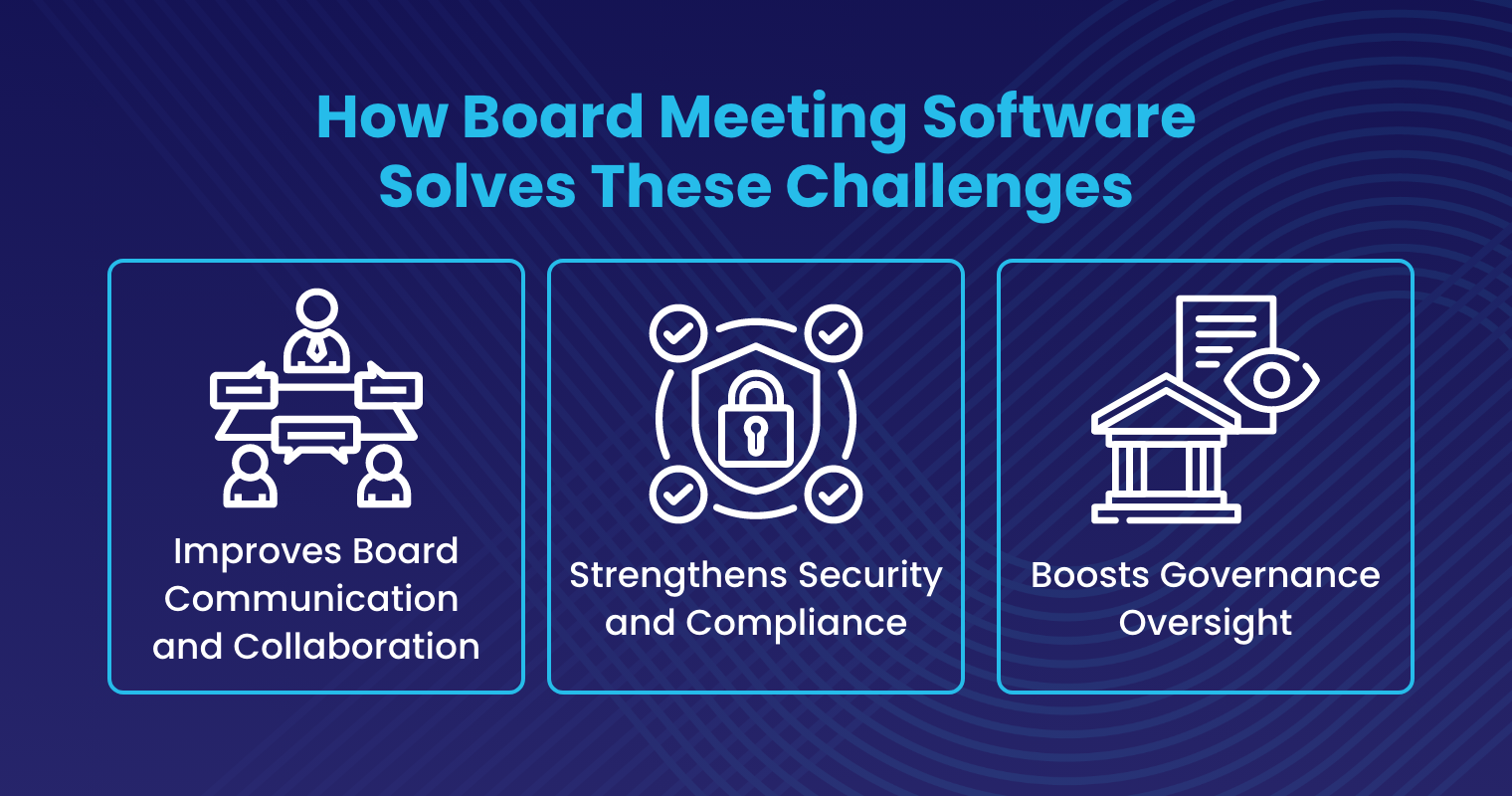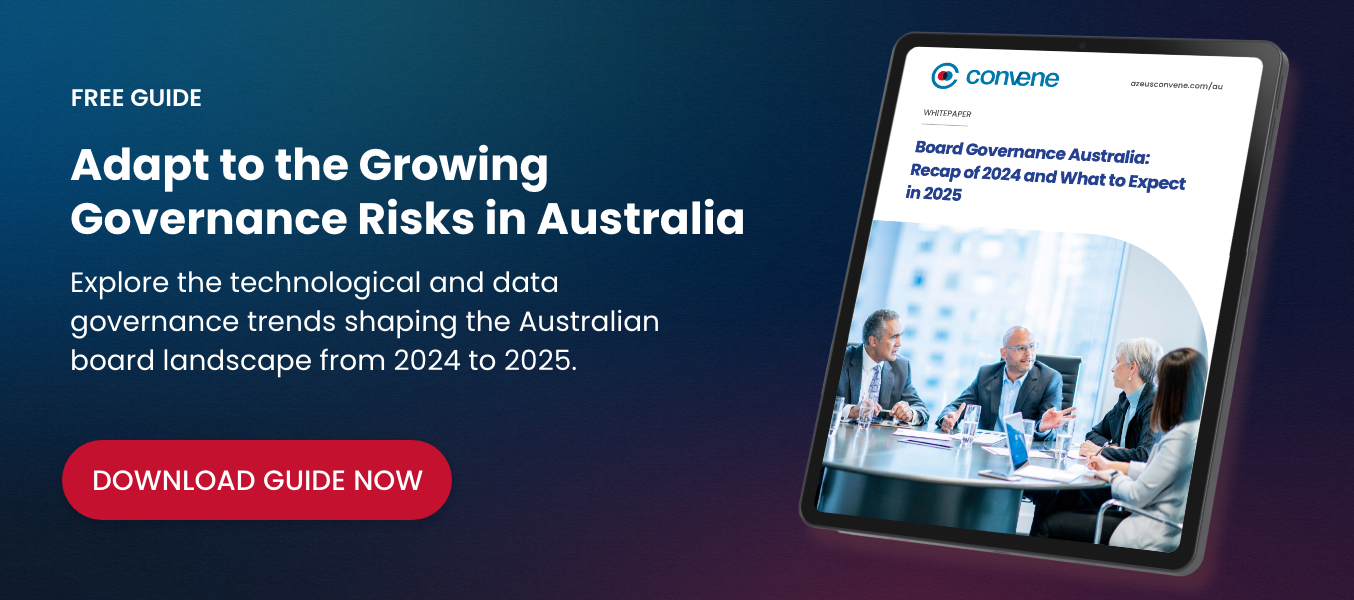Within the confines of the Australian boardrooms, several challenges can put the board under pressure. Some are as minor as handling meeting logistics, while others are as complex as reviewing compliance requirements or planning new strategies. However, the one challenge that could truly test the board, especially with the new mandatory climate-related disclosure that took effect in January 2025, is year-end reporting.
Under amendments to the Corporations Act 2001, Australian entities — particularly large businesses and financial institutions — are required to prepare a sustainability report in accordance with the Australian Sustainability Reporting Standards (ASRS). This is to be released at the same reporting period as the related financial statements, which adds more pressure on the already-demanding year-end reporting cycle.
As the season approaches, boards face new burdens to deliver comprehensive and timely board reports. However, the process doesn’t need to be as taxing and overwhelming, with proper planning and the right digital tools, such as board meeting software. This article covers everything you need to know to manage year-end reporting effectively.
What is an end-of-year report?
An end-of-year report, often referred to as a year-end report or annual report, is a formal document that outlines the organisation’s financial health, strategic updates, and sustainability disclosure to serve as a basis for planning. This is produced at the close of their fiscal year, on or before the 30th of June, to provide key stakeholders with transparent, summarised information of the past year.
In Australia, companies are required to lodge these reports with the Australian Securities and Investments Commission (ASIC) and prepare them in line with Australian Accounting Standards. For the new sustainability report, companies must follow the ASRS’s guidelines, which were patterned after the International Sustainability Standards Board (ISSB) framework to accommodate the Australian-specific circumstances.
Why Year-End Reporting Matters to the Board

A year-end report enables boards to assess not only their organisation’s financial standing but also its long-term resilience. Here are three reasons why you should treat year-end reporting with the highest priority:
Demonstrates accountability and oversight
Australian boards operate within one of the world’s most stringent corporate governance frameworks. As ASIC intensified its focus on financial reporting quality, it expanded programs targeting audit quality and financial reporting standards. This regulatory scrutiny means year-end reporting has become a litmus test for board effectiveness.
Such scrutiny is closely tied to the duties imposed under the Corporations Act 2001, which states that directors bear personal responsibility for ensuring the accuracy and completeness of financial reports. It even extends beyond mere compliance as boards must also demonstrate that they have exercised due diligence in overseeing the reporting process, from drafting to publication. Lapses in oversight could mean regulatory sanctions or personal liability for board directors.
Strengthens communication and transparency
Year-end reports act as an essential bridge of communication between management and the board, as well as between the organisation and its external stakeholders. Through a shared reference point, everyone involved in the operations remains informed and aligned with how the organisation is performing and progressing. Additionally, it reinforces the board’s credibility in overseeing long-term value creation.
Enables informed decision-making
Effective year-end reporting enables boards to assess whether their strategic initiatives deliver expected outcomes. This assessment is crucial for companies operating in sectors exposed to climate-related risks, regulatory changes, and market volatility, like finance and energy.
The quality of year-end reporting directly impacts a board’s ability to make informed decisions about resource allocation and risk mitigation. Well-planned reports can equip directors with clarity and confidence to set priorities for the following year. Conversely, poor reporting processes can leave boards with incomplete or outdated information, potentially leading to suboptimal strategic choices.
Common Challenges During Year-End Reporting
No matter how big or small the mistake is, errors in year-end reports can be costly. To avoid setbacks and potential damages, boards must remain vigilant with their preparation. Below are three of the most common challenges your board must know during this critical period so that you can act proactively:

Ensuring data accuracy
New research by Iron Mountain and FT Longitude reveals that companies worldwide have lost nearly AUD400,000 in the past year due to data integrity flaws, with many also facing strategic consequences. In Australia, 48% of surveyed organisations reported that data integrity issues caused a loss of competitive advantage, the highest rate among all markets surveyed. This underscores the importance of ensuring the accuracy and consistency of data to deflect financial losses and other risks.
Data integrity issues can stem from manual data entry errors and delayed inputs, among other reasons. While mostly prevalent in companies with international operations, such issues are also found in local organisations that lack robust reporting systems. If not addressed, delayed or incomplete data can quickly lead to erroneous financial statements or cause strain in the company’s financial position, as per the abovementioned.
Without a centralised reporting framework, information from disparate sources can be inconsistent, misaligned, or, in some cases, entirely overlooked.
Managing time effectively
Year-end reporting periods create intense time pressure for Australian boards, given the compressed timeframes between the financial year-end (30 June) and statutory reporting deadlines. The four-month window for lodging annual reports with ASIC may seem generous, but without proper preparation, the time needed to review draft reports, resolve queries, and ensure accuracy before finalisation may still fall short.
As if these pressures weren’t enough, the introduction of sustainability reporting has further tightened the timeframe. Boards must now oversee the preparation of both financial and climate-related reports at the same time, requiring enhanced coordination and resource allocation.
It doesn’t help that most businesses are still using traditional reporting processes, making time management challenges even worse. Email-based communication creates version control problems. Manual document compilation is time-consuming and error-prone. Face-to-face meetings require complex scheduling coordination that can delay decision-making, therefore delaying the reporting progress.
Maintaining regulatory adherence
Australian businesses navigate a complex web of regulations. In addition to the Corporations Act 2001, they must follow Australian Securities Exchange (ASX) listing rules, industry-specific regulations, and new sustainability reporting standards. These regulations are often updated to meet certain demands, making ongoing compliance a moving target.
To survive, boards must ensure their reporting processes are flexible enough to accommodate new requirements without compromising existing compliance obligations. Failing to comply could mean penalties, legal issues, or worse, damage to their reputation.
How Board Meeting Software Addresses Year-End Reporting Challenges
By automating workflows and centralising information into a single, accessible platform, board meeting software gives way to accurate, timely, and transparent year-end reporting. This allows directors to focus on strategy rather than paperwork. More than these benefits, here are other ways leveraging the tool can help Australian boards:

Centralises access to reports and documents
Modern board management software fundamentally transforms how Australian boards approach year-end reporting by creating centralised, secure platforms for information sharing and collaboration. Rather than relying on fragmented email communications and shared drives, boards can maintain comprehensive oversight of the reporting process through integrated digital workspaces.
One of the reliable tools you can use is Convene board meeting software. This platform can help improve reporting workflows by providing Australian boards with secure, cloud-based environments where all reporting materials can be accessed, reviewed, and annotated in real-time — in one centralised space. Directors can provide feedback on draft reports during and outside meetings and track resolution progress without the delays inherent in traditional communication methods.
Improves board collaboration
For companies with distributed teams around the world, Convene’s collaborative features, like live video conferencing, review rooms, and integrated digital signatures, enable seamless participation. Directors can review and approve materials according to their schedules, while maintaining complete visibility of other board members’ contributions.
Advanced annotation and commenting features also allow for detailed feedback on specific report sections, creating audit trails demonstrating due diligence in the review process. This capability is valuable for satisfying ASIC’s expectations around board oversight of financial reporting.
Strengthens data security
Security considerations are paramount for Australian boards, given the high-profile cyber attacks that have targeted major Australian organisations in recent years. Just in August, one of Australia’s largest telecom companies, iiNet, was hit with a data breach that exposed hundreds of thousands of customer phone numbers and home addresses.
Board meeting software addresses these security concerns through enterprise-grade security features that often exceed the protection available through traditional communication methods. Partnering with Amazon Web Services to ensure secure and reliable hosting, Convene board meeting software incorporates multi-factor authentication, end-to-end encryption, and comprehensive access controls that protect sensitive reporting information throughout the review process. The software is also IRAP-assessed and HIPAA-compliant, providing an added layer of assurance for data protection.
Ensures board and regulatory compliance
Compliance features built into a board meeting app help Australian boards navigate complex regulatory requirements more effectively. Automated retention policies ensure that board materials are preserved per statutory requirements while comprehensive audit trails document who accessed what information and when, supporting compliance with corporate governance obligations.
Moreover, version control capabilities eliminate the risk of directors reviewing outdated materials or providing feedback on superseded drafts. This is vital during year-end reporting when multiple document versions are being developed simultaneously across different workstreams.
Boosts governance oversight
Leveraging board technology enhances governance oversight by providing boards with visibility of the reporting process from initiation through to finalisation. Dashboard features enable boards to monitor progress against key milestones, identify potential bottlenecks, and obtain all necessary approvals before finalising reports.
Task management capabilities allow boards to assign specific responsibilities to individual directors or committees, creating clear accountability for different aspects of the reporting process. This functionality is essential for managing the multiple workstreams involved in preparing comprehensive year-end reports.
Document libraries within board management software create centralised repositories for all governance-related materials, making it easier for boards to maintain institutional knowledge and ensure consistency across reporting periods. This centralisation is important specifically for onboarding new directors, so they can easily understand the historical context and established reporting practices.
Best Practices to Follow During Year-End Reporting Season
Now that we’ve discussed the whats and whys of a good year-end report, the next step is knowing how to maximise the board meeting software during year-end close.
How to prepare end-of-year financial report? Here’s a quick list of things you should keep in mind:
- Start early and create shared calendars: Calendar integration capabilities of platforms like Convene board meeting software allow boards to coordinate their reporting schedules with other governance activities, avoiding conflicts with regular board meetings and committee sessions.
- Utilise board management software to assign tasks: Establish a detailed timeline outlining all tasks and deadlines for year-end reporting. Then, use board management software with sophisticated task management capabilities to assign specific responsibilities, set deadlines, and monitor completion rates.
- Regularly train board members and directors: Executive training is crucial for ensuring that management can effectively support board activities through the software platform. This training should cover document preparation standards and communication protocols, and should be ongoing to ensure efficient use.
Simplify Board Reporting with Convene Board Meeting Software

Board reporting becomes seamless and reliable when supported by the right technology. Now powered by artificial intelligence, Convene makes it easier and faster for boards to confidently prepare year-end reports.
Aside from its powerful set of features designed for board governance, the platform now has Convene AI, which automates routine tasks, generates meeting summaries, and lets users access past decisions — all with simple commands. What’s more, it transforms meeting summaries into actionable insights, so boards can move from discussion to decision without delay.
Schedule a personalised Convene demonstration today and discover how Australia’s most forward-thinking boards are digitising their year-end reporting processes for sustainable governance excellence.
Jess is a Content Marketing Writer at Convene who commits herself to creating relevant, easy-to-digest, and SEO-friendly content. Before writing articles on governance and board management, she worked as a creative copywriter for a paint company, where she developed a keen eye for detail and a passion for making complex information accessible and enjoyable for readers. In her free time, she’s absorbed in the most random things. Her recent obsession is watching gardening videos for hours and dreaming of someday having her own kitchen garden.





